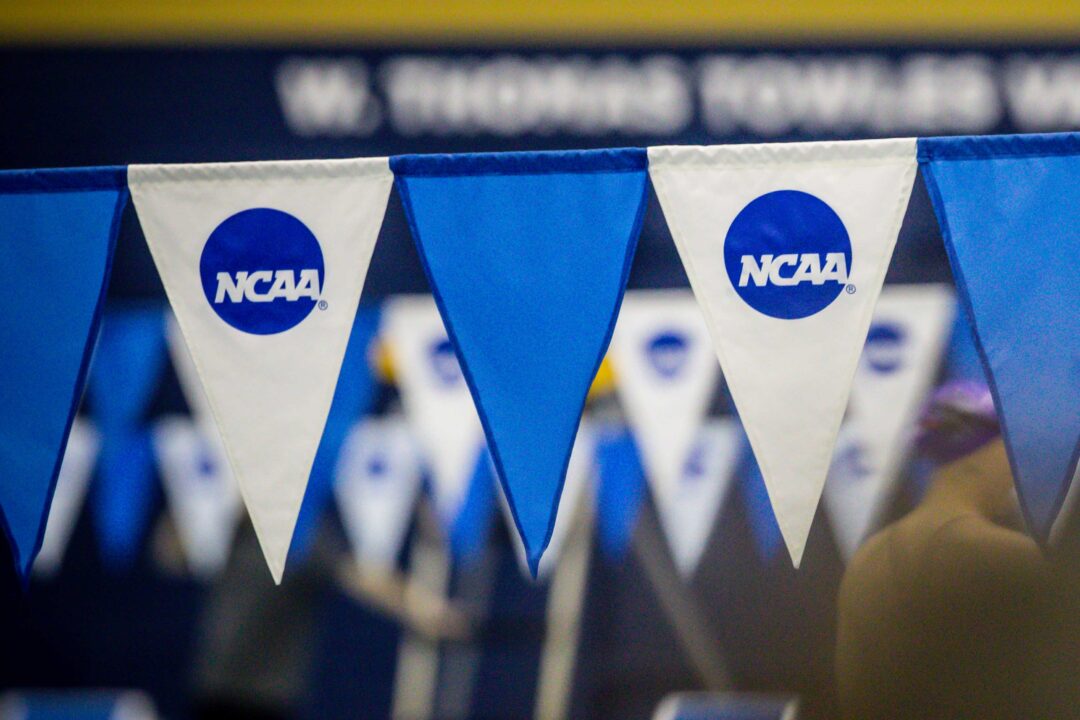The NCAA Division I Committee has decided that it will continue with timed finals relay events, online coaches’ meetings, and going without backup timers for the 2023 NCAA Championships meet.
All three of these procedures were first implemented during the 2021 NCAA Championships due to COVID-19 safety protocols. They were then kept for the 2022 Championships in light of COVID-19 surges.
The most significant of these decisions is the committee’s decision to keep timed-finals relays for the foreseeable future. According to the post meet survey sent to coaches, there was relatively positive feedback regarding the format of the relays in both 2021 and 2022, which contributed to the decision. Prior to 2021, all relays, with the exception of the 800 freestyle relay, were swum in the prelims-finals format at the NCAA Championships, with the top 8 teams out of prelims qualifying for the A-final and the next 8 relay teams making it back in the B-final.
Unlike most international competitions, a majority of teams did not switch out any of their swimmers between prelims and finals, giving some athletes upwards of 3 additional races to swim over the course of the meet. At the 2019 NCAA Championships, across both the men’s and women’s competitions, there were only 3 relay events in which the top team out of prelims was not the same team that ultimately won the A-final: the men’s 400 freestyle relay, the women’s 400 medley relay, and the women’s 400 freestyle relay. In all three events, the winning team in finals switched its line-up from the prelims race.
In addition to being a move triggered by the pandemic, the decision to eliminate back-up timers also comes following the committee’s review of the OMEGA timing system, which they decided was successful in accurately reporting timing information. The elimination of back-up timers will only be in place if the OMEGA system is used, however.
Likewise, the decision to move all coaches’ meetings remote comes after the coaches’ survey showed a positive response to the online meetings. Traditionally, in-person meetings were held with coaches before the start of the meet. However, since the pandemic, online meetings have begun to take precedence across all levels of swimming.
Other topics that were discussed at the committee meeting included altering the team seating selection process, ticket allocations, and the procedure on the podium in the case of a tie in an individual event.

Awesome. Now do D2 and D3
The biggest impact imo was felt in the 100 freestyle. You would often see a handful of scratches for borderline “B” final swimmers out of the 100 free to focus on getting the relay into the top 8. Last year there were almost no scratches.
Another short sighted decision which will undermine training. This and many other decisions have separated the college season further from the kinds of things that make long course swimming better. More glorification and insulation of sprint and power off walls and less emphasis on actual swimming.
College swimming and International swimming are related and both important. We continue to emphasize college swimming above all else and our work ethic continues to decline.
Ah yes, requiring the top swimmers to race superfluous prelim relays is the missing piece that will finally allow the US to start having international swimming success. If we bring back these three extra relays, the swimmers will train so much harder that at least one will go on to medal in Paris, whereas without those three extra relays, none of them will. /s
Straw man argument.
I never said it was “the missing piece”. It is one decision of many over the years that have had a cumulative effect.
Why is it that NCAA winning times for the 1980s still place top 8 or close in the 500 or 1650 ? And that’s without tech suits. If you adjust 400 IM times for the roll turn w/o touching the walls Dave Wharton would still top 8 most years. Now look at the 50, 100s and 200s. You can’t find similar times from the 80s in those events–especially the 50 and 100s.
Its a number game and its very much tied to how things are incentivized.
How are club teams… Read more »
Why should the NCAA, the colleges, and the athlete’s tuition dollars pay for distance event Olympic preparation if that’s not what the participants want? If someone wants better distance event performance, then maybe they or their national governing body pony up cash to make it a reality.
Could someone remind me/I missed this in the article:
Does everyone swim at night or just the top 8/16 relays swim at night?
Everyone.
This is great…gives teams incentive to get a top 8 seed and swim in final heat. Makes Conf championships way more exciting
Top 4 seed…
I would argue that there are advantages to being seeded outside of the top heat in short course.
A governing body actually soliciting feedback and then listening to it? Amazing! Here’s hoping teams don’t leave empty lanes at conference meets again this year…
Timed finals for the relays make a lot of sense. But I did love the drama at the end of prelims sessions of seeing who goofed their relays and missed the A final.
Is this for all divisions?
Not necessarily. This information is from notes from the NCAA Division I Swimming & Diving Committee. We have not seen notes from the D2 or D3 committees.